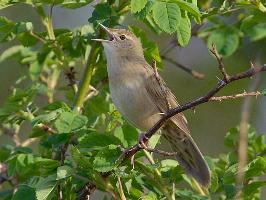
Poids et mesures
| Longueur | de 12 à 13,5 cm |
|---|
Description de l'animal
The Common Grasshopper Warbler, scientifically named Locustella naevia, is a small, inconspicuous bird that is more often heard than seen, owing to its excellent camouflage and secretive nature. This species belongs to the Locustellidae family, which is known for its members' distinctive singing abilities that resemble the sound of grasshoppers, hence the name. The Common Grasshopper Warbler is found across much of Europe and the western parts of Asia, with many populations migrating to sub-Saharan Africa during the winter months to escape the cold.Physically, the Common Grasshopper Warbler is a small bird, typically measuring between 12.5 to 13.5 cm in length, with a wingspan of 15 to 21 cm. It has a relatively stout build with a round body, short tail, and a fine, pointed beak that is well-suited for its insectivorous diet. The plumage of this bird is designed for camouflage among the reeds and grasses where it prefers to dwell. It exhibits various shades of brown and buff, with the upperparts being olive-brown streaked with darker shades, and the underparts being a paler buff, often with faint streaking. This cryptic coloration makes it challenging to spot in its natural habitat.
One of the most distinctive features of the Common Grasshopper Warbler is its song. The male’s song is a long, reeling trill that remarkably resembles the sound of a grasshopper or cricket, which it uses to attract a mate and defend its territory. This unique vocalization can be heard mainly at dawn and dusk, and sometimes continues for hours without pause. The song's frequency is such that it can sometimes be difficult for human ears to detect, especially at a distance.
Habitat-wise, the Common Grasshopper Warbler prefers dense vegetation, particularly in wetland areas such as marshes, reed beds, and damp meadows. It is also found in thickets, overgrown farmland, and young forest plantations. The bird's diet primarily consists of insects and other small invertebrates, which it forages for among the dense undergrowth.
Breeding season for the Common Grasshopper Warbler is from late April to July. During this time, the female builds a well-concealed nest on the ground, often in a tussock of grass or at the base of a bush. The nest is a neat cup constructed from grass, leaves, and other plant materials. The female typically lays between four to six eggs, which she incubates alone, while the male guards the territory. Once hatched, both parents are involved in feeding the chicks, which fledge after about two weeks.
Despite its wide range, the Common Grasshopper Warbler is considered to be of least concern by the International Union for Conservation of Nature (IUCN), though its populations are believed to be declining in some areas due to habitat loss and degradation. Conservation efforts are focused on preserving the bird's natural habitats and managing landscapes in a way that supports its breeding and feeding needs.
In summary, the Common Grasshopper Warbler is a remarkable bird with a distinctive song and a preference for dense, wetland habitats. Its cryptic plumage and elusive nature make it a challenge to observe, but its presence is often betrayed by its unique, reeling song that fills the air of its natural habitats from dusk till dawn during the breeding season.
Animaux similaires
Nouvelles photos d'animaux
Top 10 des animaux
- Dolphin gull (Leucophaeus scoresbii)
- Japanese macaque (Macaca fuscata)
- Greek tortoise (Testudo graeca)
- Stone loach (Barbatula barbatula)
- Galápagos tortoise (Geochelone nigra complex)
- Russian tortoise (Testudo horsfieldii)
- Diana monkey (Cercopithecus diana)
- Moustached guenon (Cercopithecus cephus)
- Common flying dragon (Draco volans)
- Galápagos penguin (Spheniscus mendiculus)
